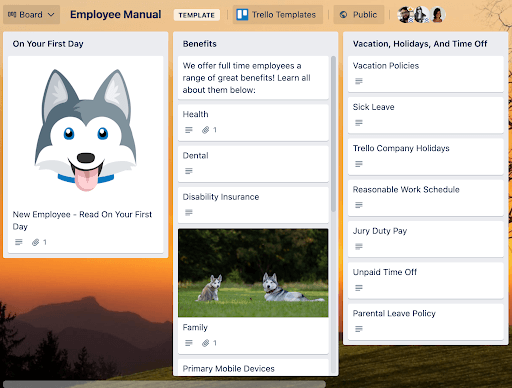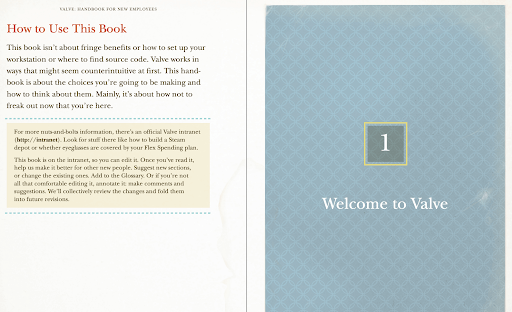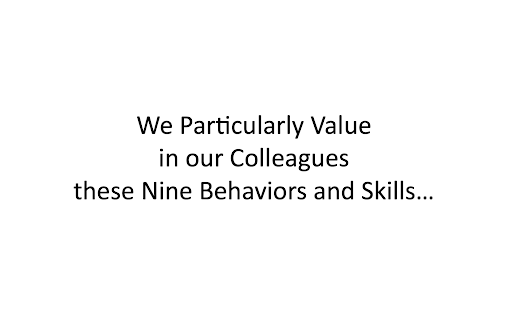The employee handbook is a crucial tool in your employee onboarding toolbelt.
It should provide clear direction and guidance for employees in regards to your organization's core values, mission, company culture, and workplace policies and procedures.
However, you don't need to include your full roster of company policies and procedures in your orientation package for new hires to read on day one. In fact, it's a sure-fire way to overwhelm them!
To create a positive new hire experience, asking them to read a long, dry document is not the best approach to take.
In this article, we'll take a look at:
- Two Types of Employee Handbooks
- What Should Go in Your Employee Handbook for New Hires
- Examples of Employee Handbooks
- Disclaimers Regarding Employee Handbooks
Two Types of Employee Handbooks
Many human resources professionals recommend having two types of employee handbooks:
- A condensed document that covers essential items new hires should know about to get acquainted with the company, and
- A more comprehensive document that can be referenced throughout an employee's time at your organization.
For new employees, I suggest providing a more concise employee handbook prior to them starting. It should give them an overview of your company culture, work environment, key company policies, and any other info that would make their onboarding process smoother.
A condensed employee handbook is perfect for including as part of your preboarding package—the comms you should be having with every new employee prior to their start date.
If you've ever done an onboarding course before, you know that new employees can be easily overwhelmed, so avoiding information overload at this crucial part of the employee lifecycle is critical. However, employees will still need a handbook that’s much more thorough on the details.
Your full employee handbook should include a comprehensive set of policies, acting as a reference documents for employees throughout their time at the organization.
Not only is this useful for employees, but it can also protect you from claims of discrimination or unfair treatment.
What Should Go in Your Employee Handbook for New Hires?
While there is no right or wrong approach to this—you need to determine what makes the most sense for your organization—there are best practices that we can look at.
The aim of an employee handbook for new hires is to help alleviate some of those anxieties that we all feel before starting a new job and get them excited for their new role.
Think of it as a summary of everything new employees want to know, but might be afraid to ask.
Here are some points and policies I recommend you include:
- Company directory or key contact list: At the very least, this should include instructions on who employees can contact in human resources for help with certain things (payroll, benefits, etc.).
- An orientation schedule that explains what to expect for the first day, the first week, and beyond. This isn't a minute-by-minute breakdown, but it gives the new hires an idea of what to expect before they begin.
- An organization chart: This will give them an idea of how the organization works, who their key team members are, and what to expect from co-workers.
- A glossary of jargon and acronyms: Every organization has its fair share of lingo and acronyms that they use. Make those first few days easier by providing something they can refer to and get caught up.
- The mission statement and core values of the organization. You can go more in-depth about why these were chosen as opposed to just listing them off. It gives new hires an indication of what to expect of your company culture.
- Company history and milestones: You can give a quick overview of important dates in your organization’s history such as the founding date, opening up a new office, reaching a certain level of revenue, or being recognized as one of the best places to work.
- General office information: If you’re back in the office, having information about parking, key cards, alarm codes, contact information for the building should be present.
- A table of contents for your full employee handbook. This is important because it gives your new hires a preview of other policies that exist, so they'll know where to seek out this information when they need to refer to it later.
- Core HR policies your new hires will be expecting, such as details pertaining to work hours and schedules, time off, company property (think computers and cell phones), and policies surrounding remote work.
- Dress code details: Whether you're remote or in-office, it's a good idea to let them know what to expect in regards to the dress code.
- Employee benefits summary: This should be more of a quick overview of what they expect, further details can be included later.
Ultimately, it's up to you what you should include. However, these are the main points I recommend you cover to create an effective employee handbook for new hires.
Related Read: What Is Employee Benefits Liability Coverage?
What information should you save for your formal employee handbook?
Now that we've covered the basic items to include in your new hire employee handbook, you may be curious what other information you should set aside as part of your more formal and comprehensive version.
For a full run-down of what to include in your handbook, I recommend reviewing the best practices in our ultimate guide to employee handbooks for more info. However, here are some basics pointers just to give you a general idea:
- An in-depth guide to how employee benefits work. You can go over health insurance, vacation time (PTO), sick leave, parental leave, and bereavement leave and the eligibility requirements for each category.
- A summary of other employee benefits you may offer and how they work, such as retirement plans or paid leave for jury duty.
- Rules surrounding employee expenses, approval processes, and reimbursement procedures.
- Employment policies such as code of conduct, workplace safety, sexual harassment, timekeeping, disciplinary action, performance reviews, equal employment opportunity, and conflict of interest.
- Social media guidelines! This is especially important nowadays so make sure to give your new employees clear guidelines on how to representing your organization on social media to remove ambiguity and reduce confusion.
- Health and safety information relevant to your industry and in compliance with local laws and federal laws. For companies operating in safety-sensitive industries, you may want to consider creating a secondary document to house safety-specific corporate policies as well.
If you need help in this area, don't sweat! We've compiled 40+ HR policies, best practices, and examples to help you simplify this process immensely.
Employee Handbook Examples
If you're looking for inspiration in regards to your new employee handbook, or employee handbooks in general, here are a few that you can look at to get some inspiration.
Trello
Trello’s is an interesting employee handbook (they refer to it as an employee manual) because:
- It's a case of Trello "eating their own dog food" by using their own product to create an employee manual.
- The nature of Trello boards makes adjusting the employee handbook on an ongoing basis a much easier task. Revisions on a trello board are much easier to track compared to making revisions in a PDF.
What’s nice about Trellos’ is that they have a breakdown of what to read on your first day, which mostly covers company policies including sick leave, vacation time policy, and sexual harassment.
For further reading they have other boards that cover employee benefits, health insurance, reimbursement, PTO, etc. Instead of having to flip through pages, it's all there in front of you.

Valve
This employee handbook went viral in 2012. Not just for the humor that it conveys, but also gives a look into an organization with a unique structure that, at the time, was very tight-lipped on their process.
It gives insight into what new hires should expect, the company’s culture, the working conditions at Valve, what to expect in a workweek, their mission statement, performance reviews, a glossary for jargon, and more.
Now note that due to the fact that Valve is entirely self-funded, retains a small headcount, and has a flat structure, their approach is likely very different than how your company runs, more so than usual. What works for them may not make sense for your organization.
Still, it's a nice, concise guide that helps convey the company's missions and vision, how they work.

Netflix
This one popped up in 2009 and is a very matter-of-fact employee handbook. While most well-known employee handbooks tend to have pleasing visuals and humor, Netflix’s handbook is blunt and straight to the point—just like their culture.
It discusses their values, how they view ‘brilliant jerks’, why they are so insistent on high performance, how their vacation time works, their reasoning behind worker's compensation, their intense working conditions, and more.
One thing I really have to commend about this employee handbook is just how no bullshit it is. It's straight-up on how Netflix works, and how it's not going to be everyone, and never pretends to be.
While this employee handbook is from 2009, not much seems to have changed with their company culture since then.

So three very different examples of employee handbooks.
The Netflix handbook is very barebones, blunt, and straight to the point, but that's the nature of their culture. It would feel out of place for them if they were to include pleasing visuals and humor.
Compare that to the Valve employee handbook—it's full of colorful language, humor, and visuals, and fits with their approach to culture.
So when it comes to the "how" of your new employee handbook, consider your culture.
Disclaimers About Employee Handbooks
Now that we've taken a look at what an employee handbook can look like (with a few examples), and what should go in it, I do want to cover some things to be aware of in regards to the employee handbook.
As great as they can be for the onboarding process, having a quality employee handbook shouldn't be at the very top of your list. Having a buddy system, a 30-60-90 day plan, or using recruiting software to automate onboarding workflows are also crucial to getting new hires off on the right foot.
Recruiting software with onboarding workflows can help streamline your hiring process by ensuring that new hires are well-informed and prepared even before they start, complementing the role of an employee handbook.
Another thing to consider is an employee handbook can easily turn into one of those documents that gets buried away in a desk. As helpful as the information can be about company policies in these documents, they may not be the most thrilling to review.
This is why I suggest when you can (and if it makes sense with the culture of your organization), to go with a more light-hearted, visual-based approach when possible.
We're visual creatures and we process them much quicker than text. With document management systems, HR teams can easily manage and update employee handbook content and keep visuals modern and up-to-date.
A final point to make in regards to the employee handbook.
A former employee of Valve (the kooky ones) had this to say about their employee handbook:
"All legit self-organizing firms have to 'leak' an official unofficial company manual. It’s got to be slickly made and fun to read. Developer marketing gurus create these productions to sway new recruits into the hiring funnel. Insiders laugh at these things."
Now, this may have just been his experience, but it's something that's important to remember. Over the years, these kinds of employee handbooks have gone viral and are admittedly great marketing tools.
But remember to keep it focused so that new employees will get the most value out of it.
If it happens to go viral and can be used to attract new talent, great! But be conscious of not designing one with only that in mind.
Next steps
With that, you now have a better understanding of the value of an employee handbook to best welcome new hires.
Again, I want to emphasize that there is no right or wrong way of putting one together—every organization is different, each with its own focus, strengths, and challenges.
Perhaps you have an old employee handbook that's just a word document that hasn't been touched in years, and nobody reads. Perhaps you don't have one at all.
Now is a good time to either start one from scratch or work upon what you already have. To help you ease the pain, I recommend using some employee handbook software to get your up and running faster.
For tools and technology to help your organization, here's our list of the best onboarding software to help you add more order to your orientation process.
Related read: Best CSR Software for Corporate Social Responsibility



